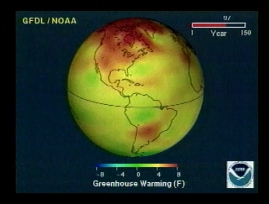Teachers' Domain - Digital Media for the Classroom and Professional Development
User: Preview

Source: ThinkTV
How does the greenhouse effect work, and what is its relationship to the warming trend? Using animations adapted from NASA, this video produced by ThinkTV demonstrates how naturally-produced greenhouse gases trap the Sun's heat in the lower atmosphere. The greenhouse effect is essential to life on Earth. But scientists fear that a rise in greenhouse gases, caused in part by human activity, is responsible for trapping too much heat and increasing the Earth's average temperature. This warming trend, if unabated, will have serious repercussions worldwide.
Earth’s average temperature is increasing—1.5°F since 1900—enough to contribute to current global climate changes. But Earth’s climate has changed many times in its history. To understand the current changes in global temperature, climate scientists are studying the relationship between the natural cycles of climate change and human activity, with particular focus on the human role in the increase of greenhouse gases.
The greenhouse effect, a natural phenomenon, keeps Earth warm. Without the greenhouse effect, Earth would be too cold for most life, with an average temperature of -18°C (-0.4°F) instead of its current average temperature of 15°C (59°F). Earth's temperature depends on the balance between the incoming solar radiation that is absorbed and how much is re-radiated to space. In the atmosphere, greenhouse gases trap heat energy by absorbing some of the reflected radiation instead of letting it re-radiate into space.
Naturally occurring greenhouse gases make up only about 0.1% of the atmosphere but absorb significant amounts of radiation. They include carbon dioxide (CO2), methane and nitrous oxide. Water vapor, which makes up about 1% of the atmosphere, is also a naturally occurring greenhouse gas. Concentrations of natural and man-made greenhouse gases have been rising since the Industrial Revolution, amplifying the greenhouse effect and holding more heat in the atmosphere.
CO2 levels have increased from fairly stable levels (280 parts per million) before the Industrial Revolution to higher levels today (392 parts per million). CO2 stays in the atmosphere between 50 and 200 years before being absorbed by the ocean or changed by a chemical reaction such as photosynthesis. This means that even if production of CO2 were reduced today, the CO2 that was added to the atmosphere decades ago would continue to affect the climate well into the future.
Climate scientists generally agree that the greenhouse effect is playing a role in changes in Earth's average temperature. The warming trend they have observed over the past 50 years is due primarily to human-induced emissions of heat-trapping gases, not to natural cycles. Changes such as shifting weather patterns, lengthening growing seasons, thawing permafrost, and lengthening ice-free seasons are all connected to this warming trend. These changes are important, because change in one part of Earth's climate system affects all of its other parts.
Here are suggested ways to engage students with this video and with activities related to this topic.
 Loading Standards
Loading Standards